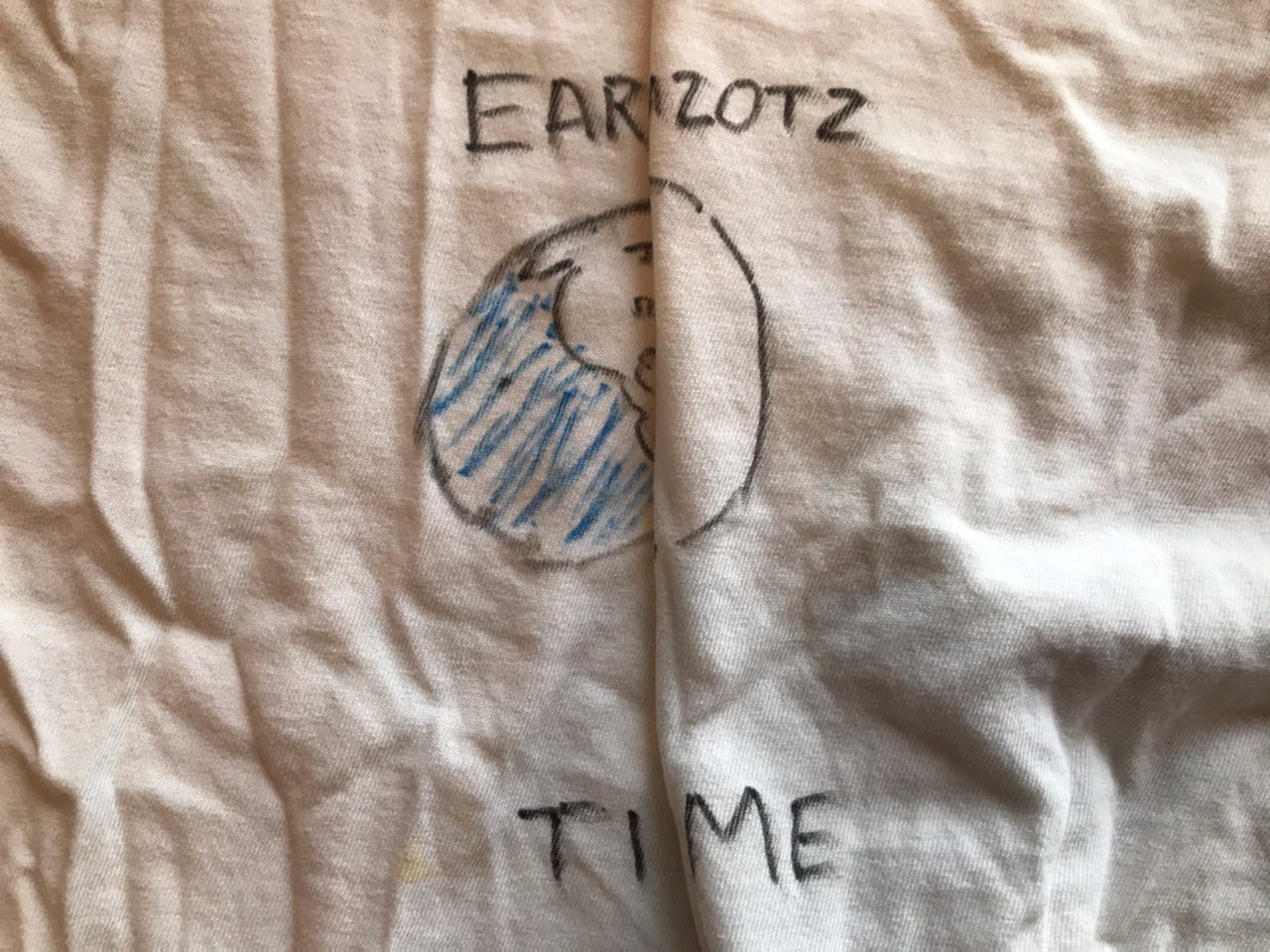A few weeks back I decided to re-read Madeleine L’Engel’s classic children’s sci fi novel, A Wrinkle in Time. I read it as a physical book borrowed from a brick-and-mortar local library, by natural or incandescent light.
I had remembered my fifth-grade teacher Mrs. Mortensen performing it as a read-aloud for us and I wanted to review the characters’ responses during their confrontation with an entity called IT, located in a place called “CENTRAL Central Intelligence” on the planet Camazotz.
Spoiler alert: IT is eventually discovered to be a “disembodied brain.”
Of course, back in the early 70s when I first heard the book read aloud, I’m pretty sure that Mrs. Mortensen read “IT” as the pronoun, ‘it’. But today, it’s almost impossible not to read it as the acronym, pronouncing the letters individually: IT. That’s how I read it now.
Re-reading it with this shift of lexicon and pronunciation, suddenly the book makes a new and utterly terrifying kind of sense. I suggest you read it. Artists and writers have an awful prescience sometimes.
Anyhow, I went looking for the book, 50 years later. What had originally motivated my search was a scene I recalled in which the teenage protagonist Meg has an encounter with IT, which had already taken over the mind and body of her brilliant younger brother Charles Wallace, and was speaking through him as if through a ventriloquist's dummy. In her attempts to prevent such an intrusion from taking over her own mind, Meg started out saying nursery rhymes as Charles Wallace had attempted, though to little avail. This didn’t occupy enough of her own will and energy. It was too rote, too automatic. She then tried the preamble to the Declaration of Independence, then briefly attempted using rational argumentation to fight IT off, with momentary success, then began shouting the names of the elements of the periodic table in order. “Hydrogen. Helium… Lithium, Beryllium…” But her father points out that this is too rhythmical. She then moves on, with her father’s coaching, to math computations. Anything to keep the invasive IT from taking her over.
This is the part I remembered and needed to re-read, because frankly I’m wondering how to do the same. The pressure is intense and growing. This Substack account is one of the ways I’m pushing back this inhuman force. It’s supremely ironic that I’m posting my writings online. This is my way of yelling: Hydrogen! Helium! — generating my own signals to jam the incoming ones, so as not to entirely forget who I am in the organic life matrix.
The young heroes of the story – Meg, Charles Wallace, and high school junior Calvin – had traveled to Camazotz via tesseract, which is described as a “wrinkle” in time that can bring distant planets close to one another. Soon after they arrive, they notice something strange: All the children in the neighborhood are bouncing their balls and jumping rope in unison on the front walkways of identical houses, until their “mother figures” – not mothers, “mother figures” – come out and clap once to call them in, also in unison. It’s a perfectly ordered world. Totally under control. “Safe.” Except for those occasional aberrations. These, they later learn, are dealt with by IT.
Ah, but there’s more. With his mind and body under control of IT, the formerly gifted, magical Charles Wallace starts extolling the virtues of this world:
“Perhaps you do not realize that on Camazotz we have conquered all illness, all deformity—”
IT goes on, speaking through Charles Wallace:
“We let no one suffer. It is so much kinder simply to annihilate anyone who is ill. Nobody has weeks and weeks of runny noses and sore throats. Rather than endure such discomfort, they are simply put to sleep.”
“You mean they’re put to sleep while they have a cold, or that they’re murdered? Calvin demanded.
“Murder is a most primitive word,” Charles Wallace said. “There is no such thing as murder on Camazotz. IT takes care of all such things.”
Everything is taken care of. It’s just that the “care” takes on some decidedly horrible forms at times.
One thing I’m sure of, though: going along with the IT program is the easy thing to do, the sensible thing, the convenient thing, the “modern” thing, the economically prudent thing, the stylish thing, the normal thing, the expected thing, the “solid citizen” thing to do. “Secure online purchasing, banking, medicine, communications.” All of this has already been socialized into us as “progress,” as “inevitable”.
What I find most worrisome at present is how few people seem to realize that we have been collectively herded in this direction and that now or in the extremely near future we face an existential choice. When the first few boards and posts of high fences are installed, I guess there’s not much to worry about. It’s when the last few boards and posts and razor wire are installed that we might start to notice. Or, maybe not. Maybe instead we focus on and draw comfort from the apparent warmth and conviviality of our former fellow humans within this enclosure.
Moo. Baa. And: oink.
This is what I’m sensing. And it looks to me like we’re fast approaching a time when even the very idea that we are in an existential confrontation and facing an existential choice will be tagged as suspicious and dangerous, a threat to collective security. Thing is, if we don’t realize we have a choice to make, the choice is in effect already made. This in turn makes things easier for IT to continue IT’s pattern of usurpation and colonization.
Here are some patterns to watch for: normalizing and rationalizing our enclosure and confinement, or reimagining various kinds of progressive confinement as new forms of freedom, or the right thing to do. This can involve physical confinement within structures, emotional enclosure within certain acceptable parameters, and mental confinement that affects speech, personal expression, or our ability to think any but pre-approved ideas. And then there’s our progressive and general confinement in cyberspace. . . which is to say, in Nothingland, precisely nowhere. Even if all our friends seem to be here with us.
Watch also for a tendency among the IT-infiltrated to justify this “bouncing balls in unison” type of enclosure within narrow and progressively narrowing spheres of variability. Already, every word spoken into your device, and perhaps even in the proximity of our devices, is tracked and monitored, every text or email, the location of every photo taken and uploaded on your “phone,” and every instance in which you refer to IT for information. It’s all tracked. That’s the point of it. These entities can just shut up about caring or protecting us and our privacy. They do not. I see evidence only of a carefully constructed public posture for doing so, to gain our compliance.
It’s a Camazotzian control paradigm. And here’s another pattern to watch for — it’s the basic toolkit of oppression, although it takes on different forms: infiltration of the individual, isolation of the individual, and elimination of the individual. Any real deviation from prescribed and approved thoughts, ideas, or information will be met with one of these three responses in one form or another. A fourth and particularly grisly option now employed in special cases is to make a public spectacle of someone’s infiltration, isolation, or elimination to serve as a warning to others not to deviate. You’re cancelled, deplatformed, your electronic assets frozen. You’re fired, shadow banned, demonetized, professional license gone. And everything from bone saws to Belmarsh can serve as tools to make examples of especially troublesome individuals.
And on we moo.
“But this isn’t happening!” some will say. “That’s just a children’s book from the 1960s. It’s a sci fi fairy tale! Fantasy! This isn’t Camazotz That’s just crazy talk! We’re happy here!”
The beautiful, intuitive and wise Charles Wallace, having fallen prey mind and body to IT, would probably agree:
“Oh Meg, you’ve got to stop fighting and relax. Relax and be happy. Oh Meg, if you’d just relax you’d realize that all our troubles are over. You don’t understand what a wonderful place we’ve come to. You see, on this planet, everything is in perfect order because everyone has learned to relax, to give in, to submit.”
Hold on, folks. Our arrival on Camazotz is immanent unless evasive action is taken. First priority: generate your own signals, find your true voices. We must remember and express who we are. We must also take inventory and assess our behavior and thought patterns, and the degree to which we have already been infiltrated and commandeered.
And, maybe read this book. One thing its overall plot line might suggest is, while it’s still basically up to us to find ways to courageously step up to this challenge, maybe we’re not in this thing alone. Maybe there are helpers out there. L’Engle got the other parts of the scenario basically right. So it’s worth considering.





